STAGE &
SCENIC DESIGN
SCENIC DESIGN

-
If you required a period looking portable theatre for
your faire, you might consider creating one using the following requirements:
- loosely modeled after The Globe's performing space,
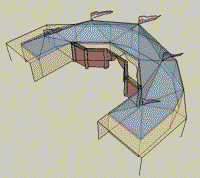
- fully tented look including five flags on top,
- draped and curtained entrances and exits,
- 24' by 10' main plus 35 sq. ft. upstage performing space, and
- controlled sightlines.
- Easily incorporate standard 4' x 8' short theatrical platforms,
- backstage area for storage, preparation, moving on/off, and SFX,
- green room,
- costume storage and changing area,
- sleeping area for 24 hour security of property, and

- merchant and/or concession space.
- Relatively easy to erect and disassemble,
- packable and transportable,
- rain, fire, and up to 60 mph wind gust proof, and
- made of modern modular components to facilitate repairs.
Royal Magick brings the stage and you use it. The cost is a fraction of your anticipated expense.
- General

The pavilion is a contemporary yet distinctive "ren-legal" appearing portable structure. It is designed specifically for outdoor theatrical performance. The requirements for performing portable "stage magic" directed the details.
The custom top is fire and waterproof Sunbrella fabric, the unseen internal supports are five modular E-Z UP® frames, and the sides are fire proofed canvas.
- Background
(The journey resulting in the creation of this structure from the inadequacies of a stamdard flat platform backdrop may be of interest. It is chronicled on the Tent History page.)
- Footprint
A space 55' wide by 35' deep in required to hold the stage, this includes space required for anchoring ropes. The space should be flat, level, and solid especially the surrounded 24' by 10' open performing space and trapezoidal curtained upstage area. Of course, space for audience in front of the stage is also required; we suggest reserving at least 60' wide by 40' deep at a minimum.
- Height
At its peak, the structure is very high including flags. It does not fit well under trees. However its tapering top allows some "snuggling up" to branches. Please consult if trees are involved.
 Attraction -- audience size considerations
Attraction -- audience size considerations
The size, shape, lines, colors, details, and decorations of the surround are designed to subtlety attracts people. These announce, "something happens here". The hay bales, benches,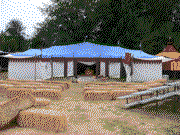
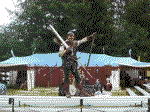
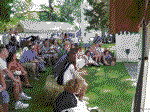 stands, or whatever placed for audience seating confirms the idea of "entertainment".
The space required for both seated plus standing audience needs to be planned.
When audiences are attracted, the audience spread can affect and block nearby merchant spaces.
stands, or whatever placed for audience seating confirms the idea of "entertainment".
The space required for both seated plus standing audience needs to be planned.
When audiences are attracted, the audience spread can affect and block nearby merchant spaces.
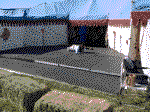
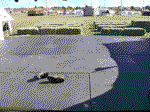

(Note: The event supplies the seating and any platforms -- Royal Magick does not presently transport or provide these.)
- Orientation -- considerations
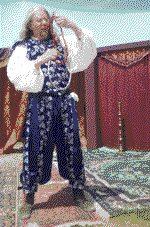 We believe the audience should comfortably see the performers on stage which means the sun should be at the audience's back.
This orientation also provides adequate illumination for the stage. Although many hobby performers complain, we logically
prefer "to look into the sun while performing."
Whenever possible, the stage should be oriented to keep the sun out of the audience's eyes.
We believe the audience should comfortably see the performers on stage which means the sun should be at the audience's back.
This orientation also provides adequate illumination for the stage. Although many hobby performers complain, we logically
prefer "to look into the sun while performing."
Whenever possible, the stage should be oriented to keep the sun out of the audience's eyes.
We lend and sell quality silk parasols for individual's use when the sun does cause problems for the audience.
- Placement -- traffic flow considerations
An entertainment destination should be placed as an attractor and/or anchor point. Our structure is solid and must be treated as a block. However, it can be placed so other booths and traffic follow a logical flow.- inline -- (Shasta, Silverton, Newport renfaires)
- corner -- Because of its "curved shape" the structure can
fill corner spaces. The front line of other booths is 18'
from the "back sides" of the structure. Although traffic
is guaranteed to nearby booths, stagnant audience spill-over is
a concern. (Utah, Boulder City, Port Angeles renfaires)
- flow around
-- it can also stand alone in the middle of a field with traffic
flowing around it and the seating area.
- As one end of an oval, the backside of the structure branches peoples to two lines of booths, entrances to seating is one choice along the lines of booths; after exiting the seating area, patrons continue down the line. (Las Vegas renfaire)
- This arrangement can be flipped so the seating area and stage is the tip or end of the oval and patrons flow to the other booths or watch the entertainment (Folsom, Washington renfaire)
-
Additional features
- Full use of the stage
There are between 8 and 16 performance slots on a stage when a faire is open for 8 hours; 1 hr = 8,

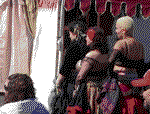



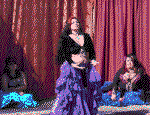


 45 min = 11, & 30 min= 16. A realistic slot allows setup, performance, collecting hat, and
cleaning up before the next act takes the stage.
Royal Magick's shows use the stage during 3 or 4 of these slots leaving the rest for other acts.
45 min = 11, & 30 min= 16. A realistic slot allows setup, performance, collecting hat, and
cleaning up before the next act takes the stage.
Royal Magick's shows use the stage during 3 or 4 of these slots leaving the rest for other acts.
Other acts love using Royal Magick's stage since it incorporates many useful aspects found in theatrical settings and lacking in most platform setups. Most appreciated are the focused attention lines, the entrances and exits, spaces for musicians, storage access that eliminates clutter, a space to prepare or hide away, and changing room.
- Full use of the stage
